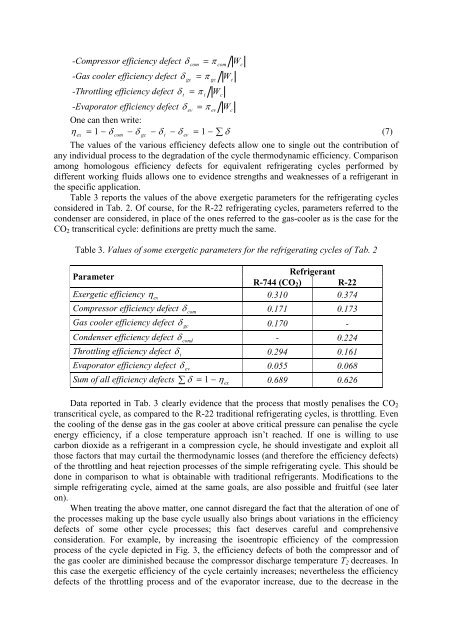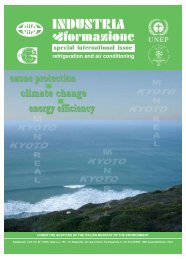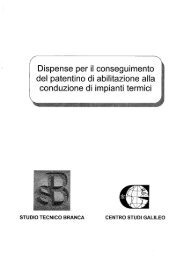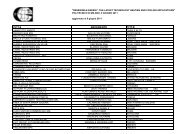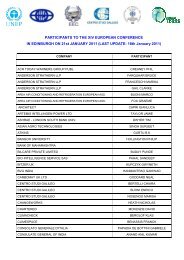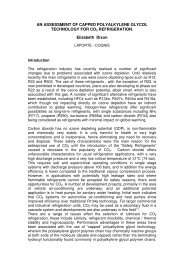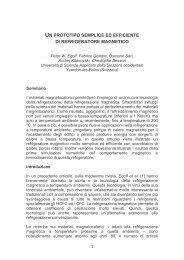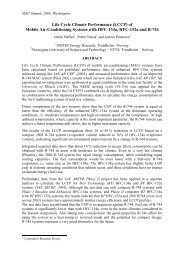PROPERTIES OF CO2 AS A REFRIGERANT - Centro Studi Galileo
PROPERTIES OF CO2 AS A REFRIGERANT - Centro Studi Galileo
PROPERTIES OF CO2 AS A REFRIGERANT - Centro Studi Galileo
Create successful ePaper yourself
Turn your PDF publications into a flip-book with our unique Google optimized e-Paper software.
-Compressor efficiency defect <br />
com<br />
= <br />
com<br />
Wc<br />
-Gas cooler efficiency defect <br />
gc<br />
= <br />
gc<br />
Wc<br />
-Throttling efficiency defect <br />
t<br />
= <br />
t<br />
Wc<br />
-Evaporator efficiency defect <br />
ev<br />
= <br />
ev<br />
Wc<br />
One can then write:<br />
<br />
ex<br />
= 1 <br />
com<br />
<br />
gc<br />
<br />
t<br />
<br />
ev<br />
= 1 <br />
(7)<br />
The values of the various efficiency defects allow one to single out the contribution of<br />
any individual process to the degradation of the cycle thermodynamic efficiency. Comparison<br />
among homologous efficiency defects for equivalent refrigerating cycles performed by<br />
different working fluids allows one to evidence strengths and weaknesses of a refrigerant in<br />
the specific application.<br />
Table 3 reports the values of the above exergetic parameters for the refrigerating cycles<br />
considered in Tab. 2. Of course, for the R-22 refrigerating cycles, parameters referred to the<br />
condenser are considered, in place of the ones referred to the gas-cooler as is the case for the<br />
CO 2 transcritical cycle: definitions are pretty much the same.<br />
Table 3. Values of some exergetic parameters for the refrigerating cycles of Tab. 2<br />
Refrigerant<br />
Parameter<br />
R-744 (CO 2 ) R-22<br />
Exergetic efficiency ex<br />
0.310 0.374<br />
Compressor efficiency defect <br />
com<br />
0.171 0.173<br />
Gas cooler efficiency defect <br />
gc<br />
0.170 -<br />
Condenser efficiency defect <br />
cond<br />
- 0.224<br />
Throttling efficiency defect <br />
t<br />
0.294 0.161<br />
Evaporator efficiency defect <br />
ev<br />
0.055 0.068<br />
Sum of all efficiency defects 1 0.689 0.626<br />
=<br />
ex<br />
Data reported in Tab. 3 clearly evidence that the process that mostly penalises the CO 2<br />
transcritical cycle, as compared to the R-22 traditional refrigerating cycles, is throttling. Even<br />
the cooling of the dense gas in the gas cooler at above critical pressure can penalise the cycle<br />
energy efficiency, if a close temperature approach isn’t reached. If one is willing to use<br />
carbon dioxide as a refrigerant in a compression cycle, he should investigate and exploit all<br />
those factors that may curtail the thermodynamic losses (and therefore the efficiency defects)<br />
of the throttling and heat rejection processes of the simple refrigerating cycle. This should be<br />
done in comparison to what is obtainable with traditional refrigerants. Modifications to the<br />
simple refrigerating cycle, aimed at the same goals, are also possible and fruitful (see later<br />
on).<br />
When treating the above matter, one cannot disregard the fact that the alteration of one of<br />
the processes making up the base cycle usually also brings about variations in the efficiency<br />
defects of some other cycle processes; this fact deserves careful and comprehensive<br />
consideration. For example, by increasing the isoentropic efficiency of the compression<br />
process of the cycle depicted in Fig. 3, the efficiency defects of both the compressor and of<br />
the gas cooler are diminished because the compressor discharge temperature T 2 decreases. In<br />
this case the exergetic efficiency of the cycle certainly increases; nevertheless the efficiency<br />
defects of the throttling process and of the evaporator increase, due to the decrease in the


